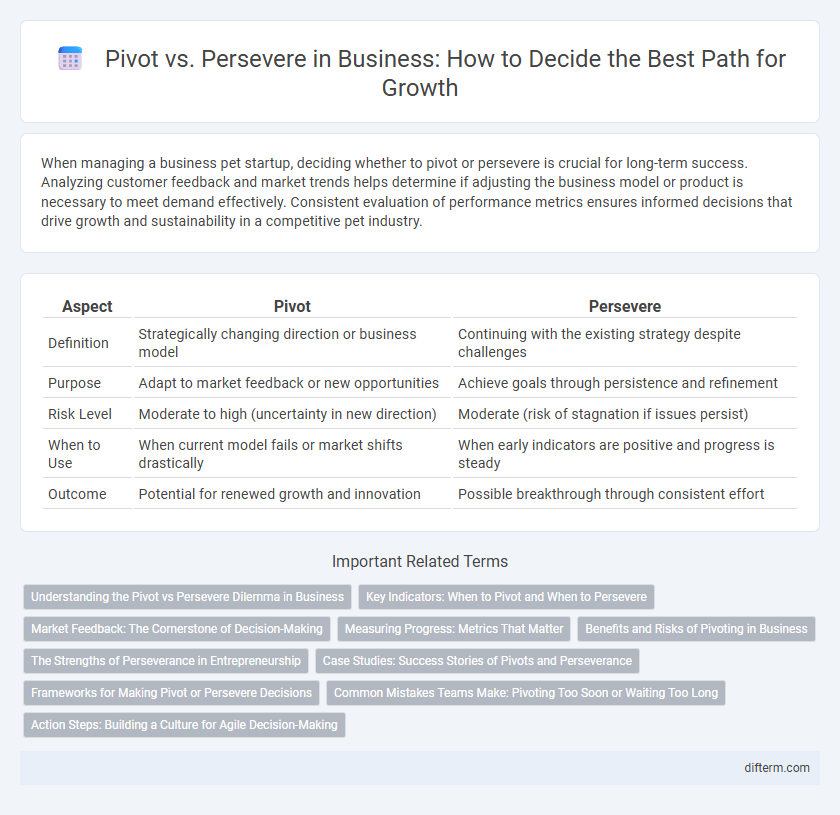When managing a business pet startup, deciding whether to pivot or persevere is crucial for long-term success. Analyzing customer feedback and market trends helps determine if adjusting the business model or product is necessary to meet demand effectively. Consistent evaluation of performance metrics ensures informed decisions that drive growth and sustainability in a competitive pet industry.
Table of Comparison
| Aspect | Pivot | Persevere |
|---|---|---|
| Definition | Strategically changing direction or business model | Continuing with the existing strategy despite challenges |
| Purpose | Adapt to market feedback or new opportunities | Achieve goals through persistence and refinement |
| Risk Level | Moderate to high (uncertainty in new direction) | Moderate (risk of stagnation if issues persist) |
| When to Use | When current model fails or market shifts drastically | When early indicators are positive and progress is steady |
| Outcome | Potential for renewed growth and innovation | Possible breakthrough through consistent effort |
Understanding the Pivot vs Persevere Dilemma in Business
The Pivot vs Persevere dilemma challenges entrepreneurs to decide between adjusting their business model or continuing with the current strategy based on market feedback and performance metrics. Key indicators such as customer acquisition rates, revenue growth, and product-market fit signal when a strategic pivot may be necessary to capture emerging opportunities or address unmet needs. Data-driven decision-making and agile responsiveness are critical to optimizing resource allocation and maximizing long-term business viability.
Key Indicators: When to Pivot and When to Persevere
Monitoring key performance indicators such as customer acquisition cost, churn rate, and revenue growth provides critical insights for deciding when to pivot or persevere in business strategy. A consistent decline in user engagement and stagnant revenue signals the need to pivot, while steady improvements in market share and customer retention justify persevering with the current approach. Data-driven decision-making based on these metrics can optimize resource allocation and enhance long-term business success.
Market Feedback: The Cornerstone of Decision-Making
Market feedback serves as the cornerstone of effective decision-making in business, guiding whether to pivot or persevere. Analyzing customer responses, sales data, and competitive trends provides actionable insights that help identify necessary adjustments or validate existing strategies. Leveraging real-time feedback minimizes risks and maximizes alignment with market demands.
Measuring Progress: Metrics That Matter
Measuring progress in business requires identifying key performance indicators (KPIs) that reflect both short-term achievements and long-term growth potential. Metrics such as customer acquisition cost, lifetime value, churn rate, and revenue growth provide critical insight to decide whether to pivot strategies or persevere with the current plan. Regular analysis of these data points ensures informed decision-making aligned with market demands and organizational goals.
Benefits and Risks of Pivoting in Business
Pivoting in business allows companies to adapt to changing market conditions, uncover new revenue streams, and stay competitive by realigning their products or services with customer demands. However, pivoting carries risks such as resource depletion, loss of existing customer base, and potential brand confusion if not executed strategically. Evaluating market data and customer feedback is crucial to mitigate these risks and maximize the benefits of pivoting.
The Strengths of Perseverance in Entrepreneurship
Perseverance in entrepreneurship fosters resilience, enabling business owners to overcome setbacks and adapt strategies without losing momentum. This steadfast commitment often leads to deeper market understanding and customer loyalty, essential factors for sustainable growth. Consistent effort and learning from failures enhance innovation and long-term competitive advantage.
Case Studies: Success Stories of Pivots and Perseverance
Examining case studies of successful businesses reveals that strategic pivots often unlock new market opportunities, as seen in Netflix's transition from DVD rentals to streaming services. Companies like Amazon exemplify perseverance by continuously innovating within their core model, driving long-term growth despite early setbacks. These success stories highlight the importance of balancing adaptable pivots with steadfast perseverance to sustain competitive advantage.
Frameworks for Making Pivot or Persevere Decisions
Frameworks for making pivot or persevere decisions in business emphasize evaluating key performance indicators such as customer acquisition cost, lifetime value, and market feedback. The Lean Startup methodology advocates using validated learning through build-measure-learn cycles to determine if a strategic pivot is necessary. Decision matrices integrating quantitative metrics and qualitative insights help leaders systematically assess whether to maintain the current course or pivot in response to evolving market conditions.
Common Mistakes Teams Make: Pivoting Too Soon or Waiting Too Long
Teams frequently make the critical error of pivoting too soon, undermining the potential of their initial business model before it gains traction, leading to wasted resources and lost market opportunities. Conversely, other teams persevere excessively, clinging to failing strategies without sufficient data or customer feedback, which results in prolonged losses and missed adaptation chances. Strategic decision-making requires balancing timely pivots with informed perseverance by closely monitoring key performance indicators and market signals.
Action Steps: Building a Culture for Agile Decision-Making
Fostering a culture for agile decision-making requires implementing clear action steps such as encouraging iterative feedback loops, empowering cross-functional teams to experiment, and establishing metrics to evaluate pivot versus persevere outcomes. Leaders must facilitate open communication channels and prioritize adaptability by integrating continuous learning frameworks within workflows. Embedding these strategies accelerates responsiveness to market shifts, driving sustainable business growth through informed, timely decisions.
Pivot vs Persevere Infographic

 difterm.com
difterm.com